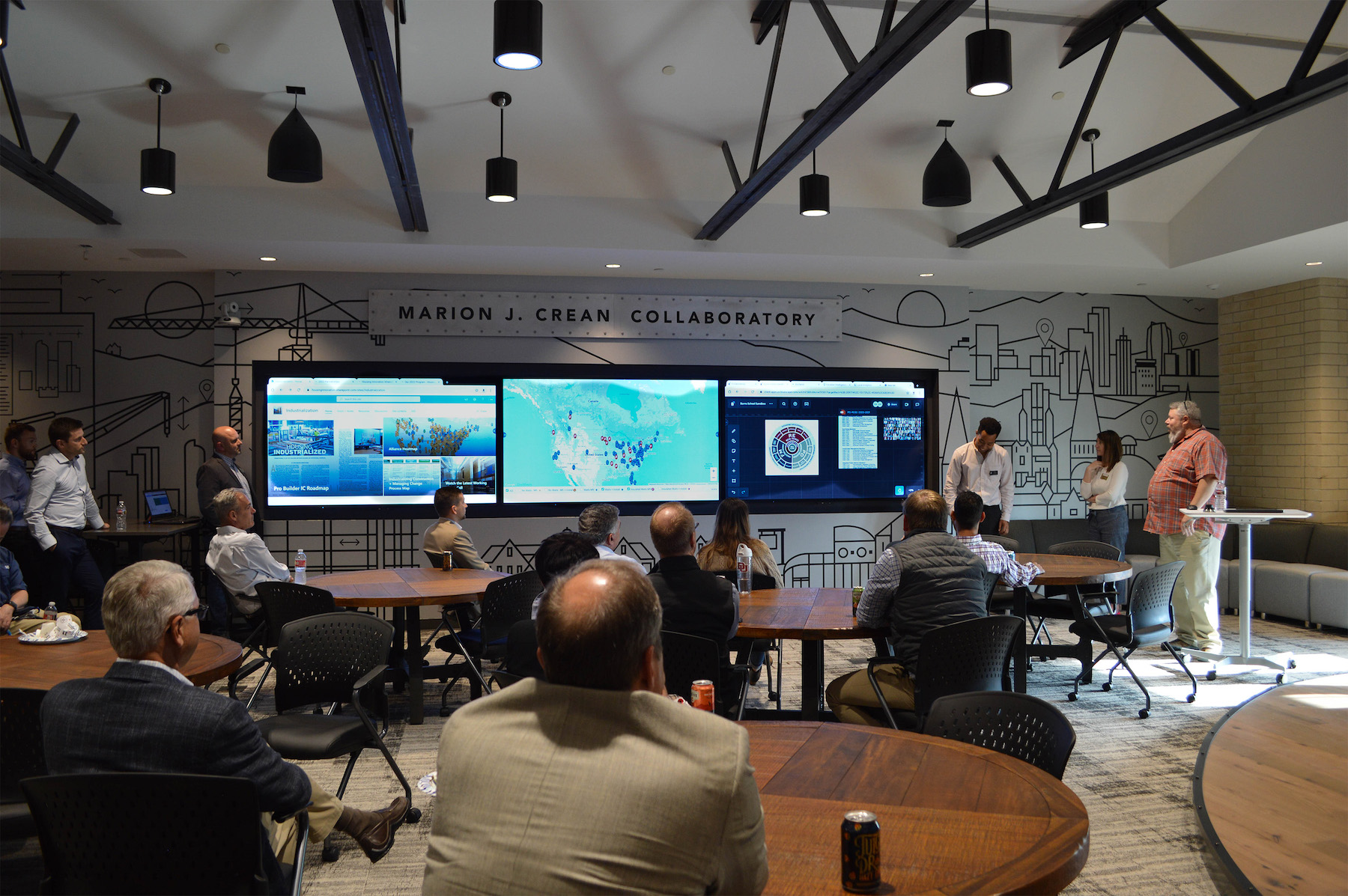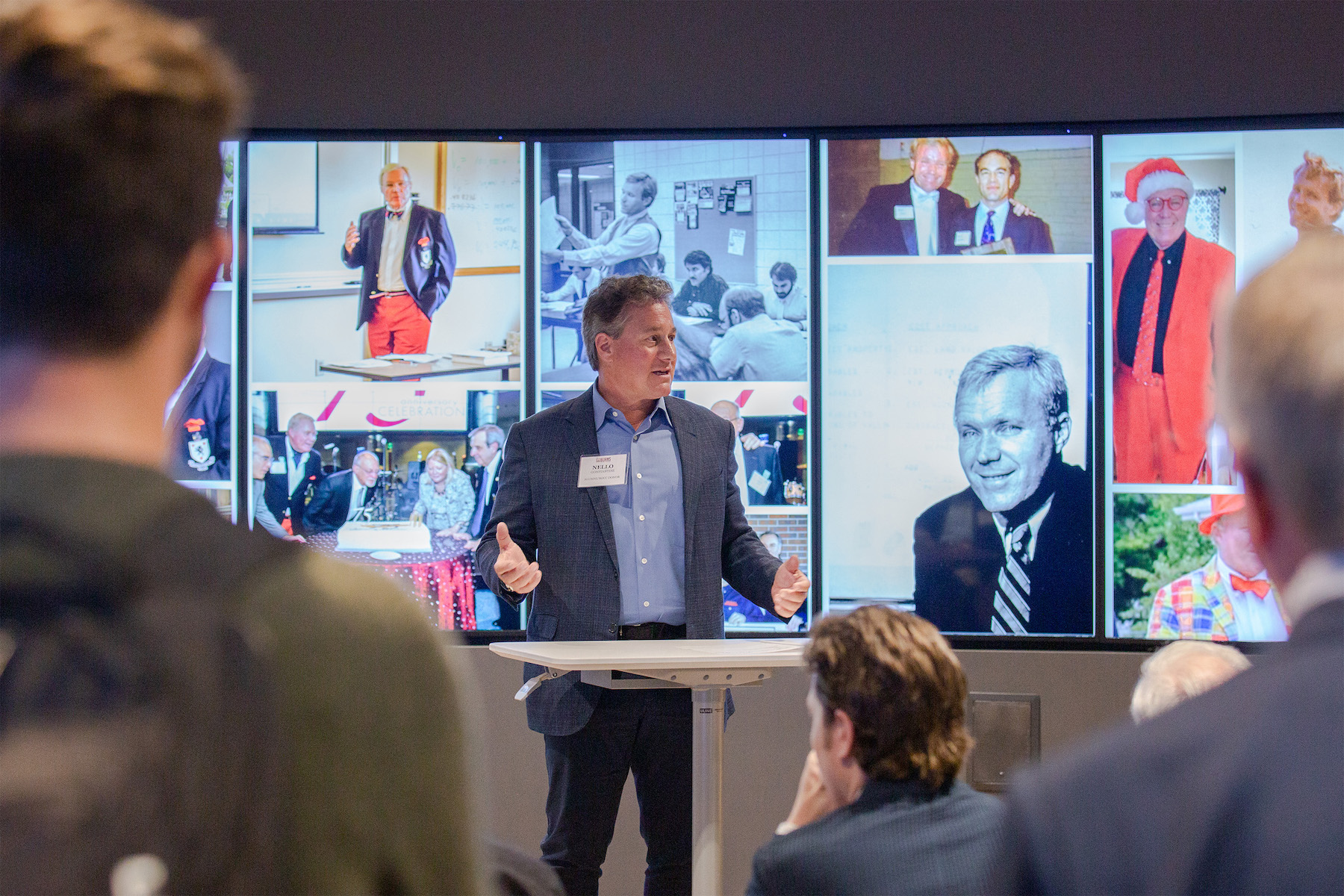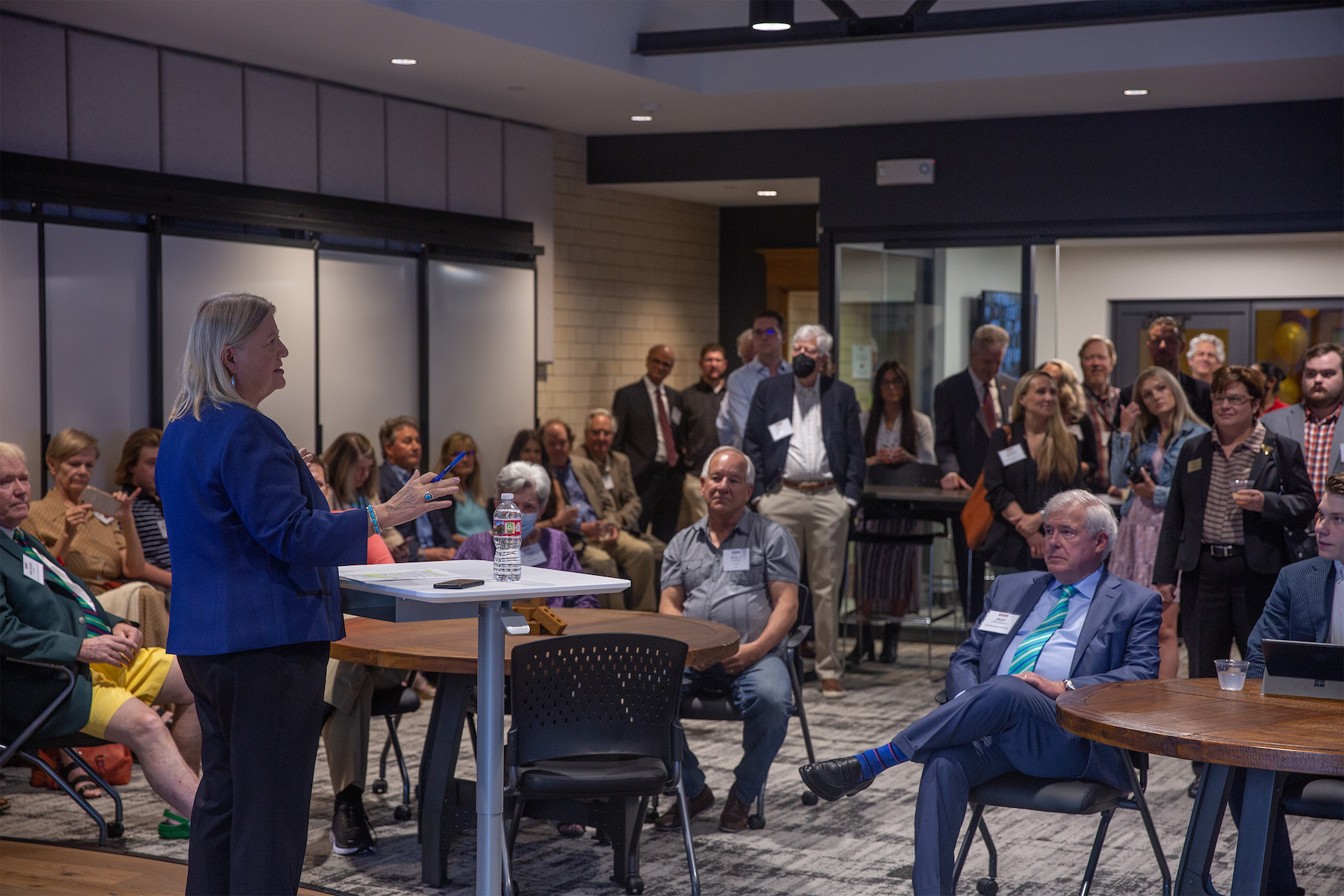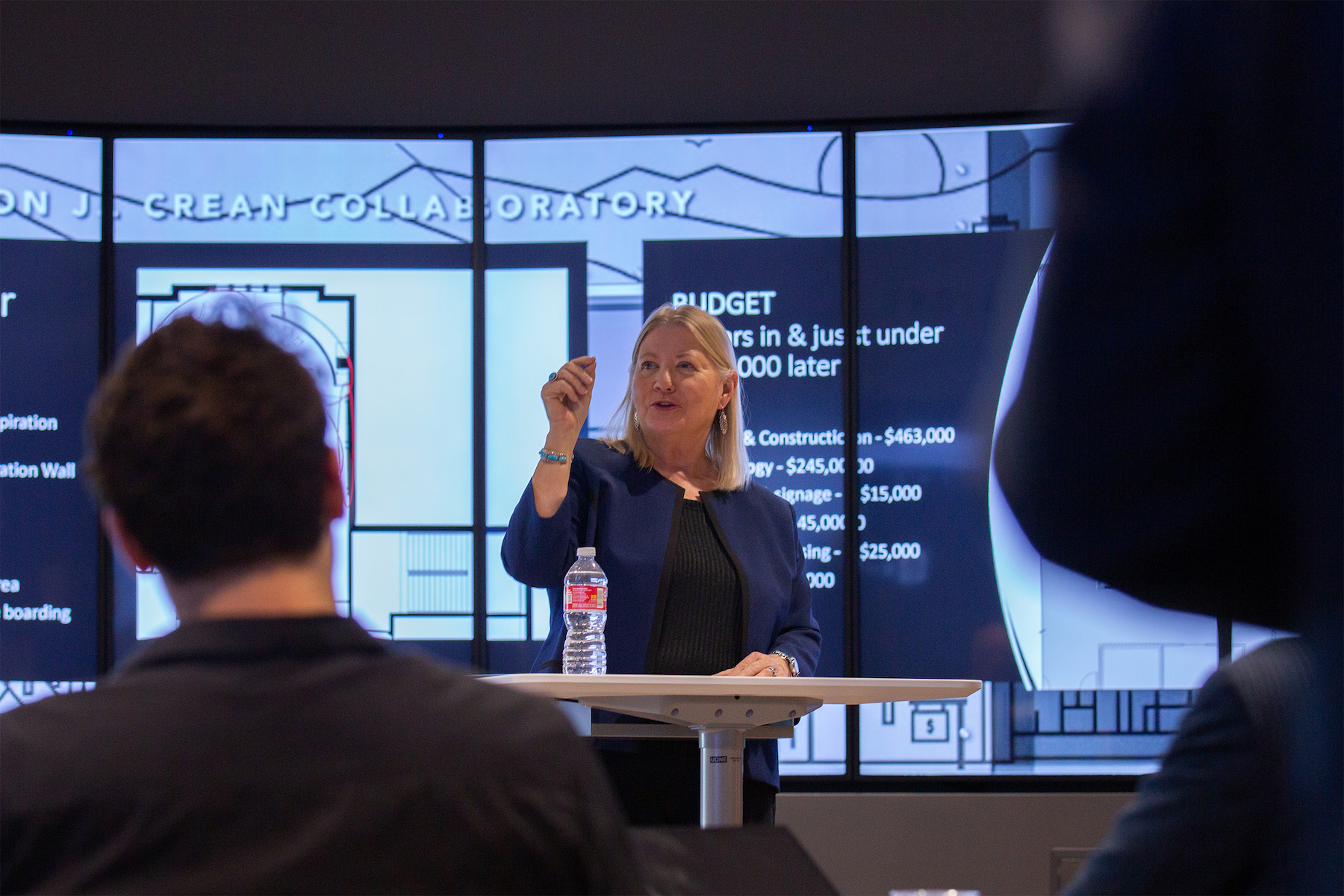Envision a classroom of the 21st century. No, it’s not all metaverse and VR headsets, but it might just be the Collaboratory. The Collaboratory—a mix of collaboration and laboratory—is a networking center being designed at the University of Denver’s College of Business.
While the technological focal point is a large panel screen coined the “Liquid Galaxy,” the focus of the classroom is to emphasize real-world learning opportunities. The overall goal is to encourage collaboration among students, increasing their interactivity with one another and the Collaboratory’s hands-on technology.
Through these tools, the students will receive real-world learning opportunities by engaging with seasoned real estate, property development, and construction professionals. This is especially done through the classroom’s second notable feature: Bluescape, a creative digital collaboration tool.

Given the declining workforce development in construction and skilled trades, the Collaboratory aims to help fill the gap. If tech-savvy students are the talent of the future, isn’t it time to create spaces that reflect and enhance their skills?
5 key features of the classroom of the future
The Collaboratory is planned to be a conglomerate of collaborative areas, from conference rooms to stage space. While the space is physically a representation of the business school’s strategy to improve industry connectivity, the real purpose of the Collaboratory is the connections. Here are some of the notable key features of the classroom, and what it might offer to the future of learning.
1. Advisor network conference room
The Marion J. Crean Collaboratory will be equipped with technology that allows students to virtually connect to a network of “advisors” located anywhere in the world (via online collaboration tools like Microsoft Teams and Zoom).
According to Eric Holt, assistant professor at the university, the college has an informal network of alumni and industry professionals that already act in the role of network advisors. He hopes the Collaboratory will help formalize those networks and offer many opportunities to the industry.
This direct access to industry leaders will help students grow and ideally learn from mistakes of the decades of experience that surrounds them.
“It has been an exciting way to connect academia and industry in ways I have never experienced before in my 24-year career,” says Holt.
2. Liquid Galaxy
This feature will allow students and alumni to explore the planet via Google Earth, engaging through a wraparound chamber of multiple LCD screens. This digital workspace brings places to life with immersive panoramic images, video, and tours.

Many believe that the Liquid Galaxy will make waves in attracting talent to the industry—and enable students to become master communicators as well. Marrying prospective young builders with industry tech, the Collaboratory aims to nurture advanced thinking from students early on in their careers.
3. Bluescape interactive virtual workspace wall
Designed as the area where the majority of classroom engagement will take place, the workspace wall is another collection of screens built for collaboration.
According to the Daniels College of Business website, it’s designed to accelerate decision making by enabling anyone to create, communicate, visualize, organize, and strategize virtually anything, anywhere, any time.
4. Barbara Jackson inspiration stage
The self described Ted-Talk-esque stage sits in front of the Liquid Galaxy, allowing industry leaders and guest speakers to have compelling presentations. The goal is to have an engaging platform that brings students and presenters together to discuss a variety of relevant industry topics.
The stage is named after Barbara Jackson, director of the Franklin L. Burns School of Real Estate and Construction Management at the University of Denver. The Collaboratory has been a vision of Jackson’s for years, according to Holt, and eight of those have been spent making the vision a reality.
5. Saipe communication workstation and huddle spaces
The Collaboratory will also have individual and group-oriented workstations, allowing for flexibility of independent work without having to leave the space. Comfortable furnishings are selected to create an inviting environment, encouraging group-work and communication.

Workforce development and hands-on learning
Workforce development is a big industry problem as of late, and many companies are struggling to hire skilled workers. How can the Collaboratory help train for the trades?
Well, according to Dennis Steigerwalt, president of Housing Innovation Alliance, the Collaboratory will forge stronger bonds between the fresh perspectives of students and the real-world challenges faced by industry.
“We aim to nurture a culture of innovation within our industry, and to establish a framework for open collaboration with value chain partners to drive new solutions for greater impact and a more resilient business,” says Steigerwalt.
The Collaboratory held its facility dedication and official opening ceremony earlier this month. It was a four-day event which started with three homebuilding industry specific VIP events.

According to Steigerwalt, the VIP events were an opportunity to introduce the platform as a national industry-student engagement vehicle and highlight the enabling technologies within the physical space, such as Bluescape and the Liquid Galaxy.
Representatives from Lennar, MiTek, Mitsubishi, Johns Manville and more attended the event. This included Gene Myers, owner and CEO of Thrive Home Builders, who found the Collaboratory to be a very compelling example of a cutting-edge teaching facility.
“The enthusiasm from students was very strong,” he said, adding that the Collaboratory will certainly aid in student recruitment to the university.
Another attendee of the event was Rodney Hall, partner at Hall-Williams Executive Search—an executive search and recruitment advisory service for real estate development, construction, and property technology.
“For me, the technology side of the physical and virtual space was cool—who doesn’t like big touch screens tethered to Google Earth?” said Hall. “However, the ability to merge, present, and compare content from multiple sources was the trigger point for me. Merging industry data for the benefit of students and corporate participants becomes the bridge between education and practical application—and extends beyond the university level.”
Hall thinks that the Collaboratory model could become the ‘go-to’ for a wide variety of industry studies and reports, ranging from land use to carbon neutral/net zero homes.
Related Stories
Laboratories | Oct 23, 2024
From sterile to stimulating: The rise of community-centric life sciences campuses
To distinguish their life sciences campuses, developers are partnering with architectural and design firms to reimagine life sciences facilities as vibrant, welcoming destinations. By emphasizing four key elements—wellness, collaboration, biophilic design, and community integration—they are setting their properties apart.
Laboratories | Oct 2, 2024
Trends in scientific research environments: Q&A with Flad's Matt McCord
As part of an ongoing series, Matt McCord, AIA, NCARB, LEED AP BD+C, Associate Principal with Flad Architects, discusses the future of the scientific workplace.
Laboratories | Sep 27, 2024
Traditional lab design doesn't address neurodiverse needs, study finds
A study conducted by ARC, HOK, and the University of the West of Scotland, has revealed that half (48.1%) of all survey respondents who work in laboratory settings identify as neurodivergent.
Laboratories | Sep 26, 2024
BSL conversions: A cost-efficient method to support high-containment research
Some institutions are creating flexible lab spaces that can operate at a BSL-2 and modulate up to a BSL-3 when the need arises. Here are key aspects to consider when accommodating a rapid modulation between BSL-2 and BSL-3 space.
Higher Education | Sep 18, 2024
Modernizing dental schools: The intersection of design and education
Page's John Smith and Jennifer Amster share the how firm's approach to dental education facilities builds on the success of evidence-based design techniques pioneered in the healthcare built environment.
Great Solutions | Jul 23, 2024
41 Great Solutions for architects, engineers, and contractors
AI ChatBots, ambient computing, floating MRIs, low-carbon cement, sunshine on demand, next-generation top-down construction. These and 35 other innovations make up our 2024 Great Solutions Report, which highlights fresh ideas and innovations from leading architecture, engineering, and construction firms.
Laboratories | Jul 3, 2024
New science, old buildings: Renovating for efficiency, flexibility, and connection
What does the research space of the future look like? And can it be housed in older buildings—or does it require new construction?
Mass Timber | Jun 26, 2024
Oregon State University builds a first-of-its-kind mass timber research lab
In Corvallis, Oreg., the Jen-Hsun Huang and Lori Mills Huang Collaborative Innovation Complex at Oregon State University aims to achieve a distinction among the world’s experimental research labs: It will be the first all-mass-timber lab meeting rigorous vibration criteria (2000 micro-inches per second, or MIPS).
Healthcare Facilities | Jun 18, 2024
A healthcare simulation technology consultant can save time, money, and headaches
As the demand for skilled healthcare professionals continues to rise, healthcare simulation is playing an increasingly vital role in the skill development, compliance, and continuing education of the clinical workforce.
Laboratories | May 24, 2024
The Department of Energy breaks ground on the Princeton Plasma Innovation Center
In Princeton, N.J., the U.S. Department of Energy’s Princeton Plasma Physics Laboratory (PPPL) has broken ground on the Princeton Plasma Innovation Center (PPIC), a state-of-the-art office and laboratory building. Designed and constructed by SmithGroup, the $109.7 million facility will provide space for research supporting PPPL’s expanded mission into microelectronics, quantum sensors and devices, and sustainability sciences.

















